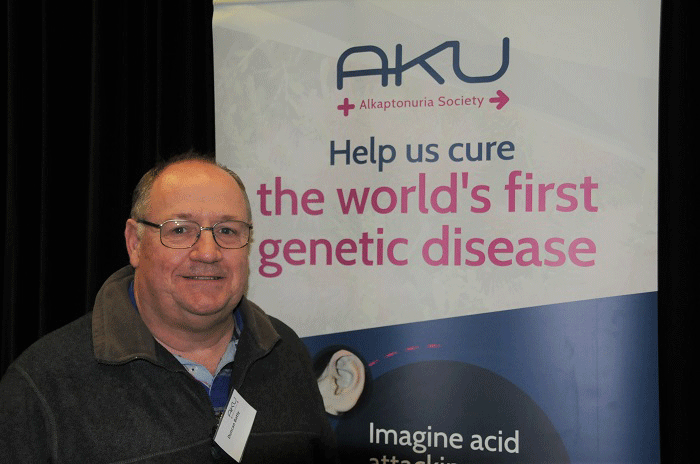The newly published results of a study held at the National Alkaptonuria Centre (NAC) show that a drug called nitisinone improves the health of AKU patients. They also show that it reverses a process called ochronosis, where a black pigment is deposited in tissue as a result of the build-up of a toxic acid. We reported this in the AKU Society blog on 29th July. This week, we talk to patient and AKU Society trustee Duncan Batty. Duncan marks ten years of taking nitisinone this August.

Duncan lives in East Anglia. He was diagnosed with AKU as a toddler. In 2000, he started getting medical support from Professor Tim Cox at Addenbrooke’s Hospital in Cambridge. Though now retired, Professor Cox was a great supporter of the AKU Society. He did a lot of early research and went to many of our scientific workshops. Both Duncan and Prof. Cox knew about nitisinone. At that time, scientists at the National Institutes of Health in Maryland, USA, were proposing the drug as a treatment for AKU, and would eventually run an unsuccessful clinical trial.
In 2008, Professor Cox got approval from the ethics committee at Addenbrooke’s to give Duncan nitisinone. This was on an ‘off-label’ basis, which allows patients to get hold of drugs not yet licensed. Duncan has been taking nitisinone, from Addenbrooke’s and then from the NAC, ever since.
In 2005-2006, he first started hearing about the AKU Society. He attended his first patient workshop in 2008. There, we asked him to take part in the very first phase of the DevelopAKUre clinical trials on nitisinone and AKU, held in Liverpool in 2009. When our office moved from Liverpool to Cambridge in 2010, he joined us as a volunteer. Duncan has a PhD in Synthetic Organic Chemistry from University College London, has held academic posts at the University of Illinois and at the Universite d’Orsay, Paris, and has worked for years in pharmaceutical research. Newly appointed CEO Nick Sireau found him to be a great source of advice. When the NAC opened its doors in 2012, Duncan was one of the first patients to attend. He has now just completed his seventh visit.

He is thrilled to hear the news from the NAC research study. He says that this fits with his own experience of the disease. One of the effects of ochronosis is that ears become dark-coloured. The colouring in Duncan’s ears has been getting less for several years. It was even recently described as ‘subtle’ by an NAC nurse – quite a compliment!
During Duncan’s first five years on nitisinone, he had four joint replacements. This didn’t mean that nitisinone wasn’t working, just that the damage to those joints was already too far gone. On the other hand, his left shoulder, which was causing him severe pain in 2008, only just now needs replacing. Plus, his heart is fine – even though he’s at the age when patients often get heart disease. Long may it last, he says.
Like all AKU patients, he lives in constant pain. Over the last three years, he has been trying to take less pain medication. He stopped taking opiate painkillers in June 2017 and now copes with just Paracetamol. Duncan understands that this might not be possible for all AKU patients. He is also not sure whether nitisinone makes it easier for him to cope with the pain.
Duncan is a trustee of the AKU Society and a scientific advisor to the DevelopAKUre consortium, which runs the DevelopAKUre trials on nitisinone. He looks forward to a better future for AKU patients and is proud to have contributed his expertise.
